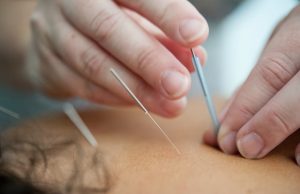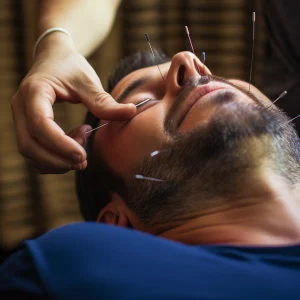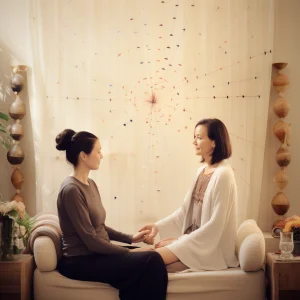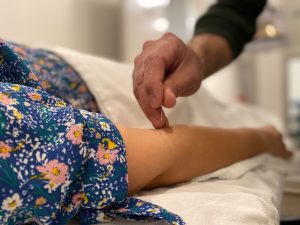Acupuncture for Pain Relief
Acupuncture is an ancient Chinese healing practice that has been used for thousands of years to treat different types of pain. It involves the very precise insertion of extremely thin needles into specific points on the body. Acupuncture aims to stimulate the central nervous system to release the body’s own natural pain relieving and anti-inflammatory chemicals.
Understanding the Concepts Behind Acupuncture
Acupuncture works on the premise that there is a vital energy force flowing through the body called Qi (pronounced “chee”). This energy flows along specific pathways known as meridians. According to traditional Chinese medicine principles, when Qi becomes blocked or unbalanced along these meridians, it can lead to illness and pain.
By inserting fine sterile needles at precise acupoints along the meridians, an acupuncturist can stimulate and regulate the flow of Qi to bring the body back into balance. Restoring homeostasis in this way allows the body to heal itself and provides targeted, holistic pain relief.
The Origins and History of Acupuncture
References to acupuncture date as far back as 100 BC, though some scholars speculate origins even earlier. According to legends, Chinese warriors wounded by arrows during battle experienced pain relief in other areas of the body. This discovery led to experimentation with needling techniques for therapy.
Over the centuries, acupuncture evolved into a core component of Traditional Chinese Medicine, used to balance energy, stimulate healing, and reduce pain. As it spread through regions like Japan, Korea and Europe, each culture adapted needling techniques and applications to fit their medical customs. For example:
- French and German styles integrate modern medical science like anatomy and physiology.
- Japanese acupuncture uses thinner needles and gentler manipulations compared to Chinese acupuncture.
- Korean techniques place special emphasis on balancing Qi in the hands and feet.
Today acupuncture continues gaining esteem worldwide for pain management and its role in integrative medicine. Recent analyses show an estimated 3 million American adults receive acupuncture yearly.
Modern Theories Behind Acupuncture’s Mechanisms
While ancient principles of meridians and Qi energy form acupuncture’s foundation, modern medicine now links its pain relieving magic to interactions with the nervous system, endogenous opioids and inflammation regulation.
Stimulation of nerves at specific acupoints is believed to activate pain gate mechanisms in the spinal cord and brain. These signals block pain from reaching the brain.
Needling releases neurotransmitters like serotonin and endorphins – chemicals that regulate pain perception and emotion.
Acupuncture reduces pro-inflammatory compounds linked with chronic pain such as IL-6, TNF-a and CRP interleukins.
So in essence, acupuncture taps into the body’s innate ability to heal and find balance. Keep reading to learn how it can help relieve many types of pain.

Using Acupuncture to Target Different Types of Pain
Clinical research on acupuncture demonstrates positive outcomes for all kinds of acute and chronic pain conditions. A systematic review spanning over 20,000 patients even concluded it provides statistically and clinically meaningful improvements compared to standard treatments or no treatment.
While study quality warrants further improvements, evidence convincingly supports acupuncture for pain including:
Chronic Pain
Conditions causing persistent non-cancer pain often respond very well long-term to acupuncture. In particular:
- Low back pain
- Neck, shoulder and general musculoskeletal pain
- Osteoarthritis, rheumatoid arthritis
- Headaches, migraines
- Dental and facial pain like TMJ
Results from multiple gold-standard RCTs and meta-analyses agree acupuncture effectively reduces chronic pain levels by up to 40-60% or higher in these common culprits. Patients enjoy benefits for at least 3-6 months post-treatment.
Cancer Pain
Cancer patients must endure intense bouts of acute pain alongside medications that cause their own misery. Fortunately, research confirms acupuncture safely alleviates difficult to treat cancer pain – even hard to reach visceral and bone pain.
Relief comes from decreasing nausea, fatigue, insomnia and hot flashes too. As an added perk, pairing acupuncture with pain medications often allows substantial lowering of the drug doses. Less drugs means less chances of adverse side effects.
Types of cancer related pain shown to improve with acupuncture include:
- Post-surgical pain
- Radiation-induced pain
- Chemotherapy-induced peripheral neuropathy
- Hormonal therapy side effects
- Bone pain from metastatic cancer
Acute Injury Pain
Even recent acute trauma and tissue injuries benefit from acupuncture for pain relief. This includes post-operative pain after surgeries, sprained ankles or knees, herniated discs, muscle strains and more. Results are enhanced when combined with standard care.
For example, back pain patients given acupuncture plus NSAID anti-inflammatories reduced pain levels twice as much as taking the medication only. Recovering from minor surgeries like dental extraction also hurts considerably less with acupuncture assisting pain management.
The key is acupuncture seems especially useful for painful inflammatory conditions – exactly what most injuries involve. Bringing that inflammation under control goes a long way towards relief.

What to Expect During Acupuncture Treatment
Now that you know the variety of pains acupuncture can help, let’s explore what to expect during a session with an acupuncturist. Treatment plans always start with an extensive health consultation, after which ultra-slim needles get strategically inserted to target healing.
Initial Health Consultation
You and your acupuncture provider have an open discussion about your medical history, lifestyle behaviors, diet and current health goals. Diagnosis incorporates concepts from Traditional Chinese Medicine too.
Your acupuncturist will:
- Examine your tongue texture and color
- Feel your radial pulse at the wrist for rhythm and strength
- Palpate areas of tenderness or dysfunction
- Note your main pain patterns and locations
This holistic perspective lets your provider pinpoint meridian imbalances that may associate with your pain. They then put together a customized treatment plan with suggested acupoints for needling.
Needle Insertion
You relax comfortably on a treatment table, often face up or facing down depending on acupoint locations. Loose clothing ensures easy access for placing needles.
Your licensed acupuncturist sterilizes all needle insertion sites first, then begins gently inserting needles just below top layers of skin. Points selected relate to your unique pain relief goals. For example, low back pain may involve needling areas along the lower back and legs. Migraine treatment targets points on the head, hands and feet instead.
You’ll feel some mild sensations as the needles get manipulated or electrically stimulated to maximize therapeutic effects. A dull ache, warmth, tingling, numbness and heaviness are common. Most patients describe the needling as virtually painless though.
Retaining the Needles
Needles remain in position from 15-30 minutes on average. This retention time lets your body adjust to the new signals and commence deep healing activities. You can take short naps or listen to soothing music during this relaxation phase.
End of Treatment
At the end of an acupuncture session, needles gently get removed and your practitioner reviews how you’re feeling. You may notice immediate pain relief, however multiple weekly sessions give the best long term improvement for chronic issues.
Follow up visits allow your acupuncturist to monitor progress, modify treatments accordingly and support your transition into self-care pain management at home.
Acupuncture Treatment Plans and Results
While everyone responds uniquely to acupuncture, clinical research gives reasonable expectations about typical treatment schedules and realistic outcomes.
How Many Acupuncture Sessions Do You Need?
The number of treatments required depends greatly upon pain severity, duration and its underlying cause. Those with longstanding, intense pain may need 12-15 sessions or more over a 2 month timeframe. Milder cases sometimes resolve within 6 weekly visits.
Generally speaking:
- Acute pain – Fewer visits, often showing benefits after 1-6 sessions
- Chronic pain – More visits needed, at least 6-12 sessions over 1-2 months
- Maintenance care – Some patients elect ongoing monthly acupuncture to preserve results
During your initial consultation, you and your licensed acupuncturist can outline an appropriate schedule per your symptoms. They’ll adjust frequency recommendations later based on how your body responds.
How Fast Will I Feel Pain Relief from Acupuncture?
Some patients enjoy immediate pain relief right after their first ever acupuncture session – almost like magic! However, it may take a few appointments before you register improvements, especially with long term pain. Consistency is key.
Here’s a general guideline of pain relief timing:
- Right away – 30% of patients
- After 3-5 sessions – 40% of patients
- 6 sessions or more – 30% patients with chronic pain
Regardless of quick responders versus slow and steady healers, sticking to your acupuncturist’s suggested treatment plan gives the best odds of optimal pain relief. Checking in regularly lets them adjust therapy based on your progress too.
How Long Do Acupuncture Pain Relief Benefits Last?
For uncomplicated acute pain like strains or dental work soreness, acupuncture often fixes the problem permanently. Just a few sessions relieves the pain with effects lasting indefinitely.
However, recurring chronic pain issues pose an ongoing challenge. Much like physical therapy or massage needs repetition to keep muscles supple, your body similarly requires acupuncture maintenance care.
Limited clinical evidence reports substantial pain reductions lasting 6-12 months for those receiving consistent acupuncture over 2-3 months. Arthritis patients may then require tune-up treatments every 3-6 months thereafter when pain creeps up.
But even if some pain returns later, getting back into acupuncture care quickly recaptures control again. Ultimately you’ll enjoy greater comfort, function and quality of life.

Is Acupuncture Safe? Understanding Risks and Side Effects
Now that you appreciate acupuncture’s potential for pain relief, how safe is it really? Given its legendary history spanning thousands of years, acupuncture maintains an impressive safety record across billions of treatments globally when practiced responsibly.
However, risks always exist with healthcare interventions. Let’s explore acupuncture’s most frequently reported side effects and who needs extra precautions.
Common Acupuncture Side Effects
Major regulatory organizations including the FDA classify acupuncture needles as medical devices requiring oversight to minimize risks. Still, some transient mild reactions occur:
- Minor bleeding or bruising at needling sites
- Mild pain, tingling or soreness locally where needles get inserted
- Temporary fatigue, lightheadedness or emotional release
These sensations typically resolve quickly on their own. Make sure to communicate any persistent or concerning symptoms to your licensed acupuncturist though.
Rare But Serious Acupuncture Risks
Potential complications from tissue trauma like lung punctures or nerve injuries are exceedingly uncommon, with incidents estimated around 1 per 10,000. Far below rates seen in standard medical procedures.
When harm occurs, it almost always associates with poor practitioner training. Ensure your acupuncturist has extensive medical knowledge plus hundreds of hours of supervised clinical training. Most states license acupuncturists today as well.
Additional risk factors involve patients with:
- Clotting disorders
- Pacemakers or medical implants
- Chemotherapy induced neutropenia
- Damaged heart valves or special arteriovenous tissues
In these cases, precautions get taken like avoiding certain acupoints or needling only very superficially. Discuss all medical history openly with your licensed acupuncturist first.
For healthy individuals seeking care from competently trained practitioners, acupuncture poses very minimal risks – certainly far less than pain medications or surgeries. The profound benefits clearly outweigh unlikely hassles.

Maximizing Your Pain Relief Results Safely
While acupuncture can work wonders easing all types of pain, success ultimately requires an integrated, responsible approach leveraging multiple self-care pillars too. Don’t neglect lifestyle habits alongside treatment.
Choose an Experienced Licensed Acupuncturist
Starting with a properly qualified acupuncture practitioner ensures you receive competent assessment and care catered to your situation. Confirm your provider has:
- Graduated from an accredited 4 year master’s program, with 2-3 years supervised clinical training
- Current state license to practice acupuncture
- Malpractice insurance coverage
- Ongoing continuing education to update technical skills
Also verify your acupuncturist utilizes only single-use disposable needles to eliminate infection risks. Shared needle practices raise red flags.
Communicate Openly
Treating pain often necessitates coordination across multiple health providers like physiotherapists, massage therapists and medical doctors alongside your acupuncturist.
Be sure to disclose:
- All medications or supplements you take
- Changes in your pain, function or other symptoms
- Any worrisome side effects you notice
This facilitates safe, integrated care modified as your needs evolve.
Engage in Healthy Habits
While acupuncture relieves many symptoms directly, you further support healing by reducing inflammation and stress through:
- Nutritious anti-inflammatory eating – whole foods, omega-3s, antioxidants, etc
- Stress reduction practices – meditation, nature immersion, etc
- Adequate sleep and movement
- Pain medications only as necessary per doctor consultation
A holistic outlook empowers you to participate actively in your own wellbeing too!
The Takeaway: Acupuncture for Pain Relief
In summary, acupuncture provides a safe, effective option for alleviating many different acute and chronic pain conditions. Ultra-slim sterile needles get inserted at specific bodily locations to tap into the body’s natural pain and inflammation modulation systems.
While perspectives on how acupuncture works exactly continues evolving, clinical results consistently demonstrate reduced perceptions of pain, improved function and better quality of life. This ancient healing art integrates beautifully alongside modern approaches for pain management.
However, quality practitioner selection, realistic expectations about treatment duration and commitment to supporting healthy lifestyle behaviors helps maximize therapeutic gains.
Give acupuncture a try to see firsthand how this classical healing technique can unlock deep pain relief!


